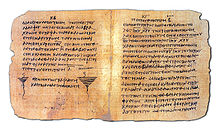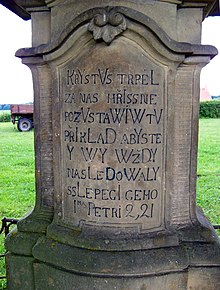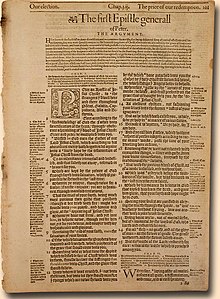

| Part of a serieson |
| Books of the New Testament |
|---|

Papyrus 46, one of the oldest New Testament papyri, showing 2 Cor 11:33–12:9
|
|
|
|
Epistles and Apocalypse
|
|
|
|
Related topics |
|
|
|
|
| Part of a series of articles on |
| Peter in the Bible |
|---|
 |
| In the New Testament |
| Other |
|
|
The First Epistle of Peter[a] is a book of the New Testament. The author presents himself as Peter the Apostle. The ending of the letter includes a statement that implies that it was written from “Babylon”, which may be a reference to Rome. The letter is addressed to the "chosen pilgrims of the diaspora" in Asia Minor suffering religious persecution.

The authorship of 1 Peter has traditionally been attributed to the Apostle Peter because it bears his name and identifies him as its author (1:1). Although the text identifies Peter as its author, the language, dating, style, and structure of this letter have led most scholars to conclude that it is pseudonymous.[3][4][5] Many scholars argue that Peter was not the author of the letter because its writer appears to have had a formal education in rhetoric and philosophy, and an advanced knowledge of the Greek language,[6] none of which would be usual for a Galilean fisherman.
New Testament scholar Graham Stanton rejects Petrine authorship because 1 Peter was most likely written during the reign of Domitian in AD 81, which is when he believes widespread Christian persecution began, which is long after the death of Peter.[7][page needed] More recent scholars such as Travis Williams say that the persecution described does not appear to be describing official Roman persecutions after Peter's death, thus not directly ruling out an early date for the composition of the epistle.[8]
Another dating issue is the reference to "Babylon" in chapter 5 verse 13, generally agreed to be a claim the letter was written from Rome. It is believed that the identification of Rome with Babylon, the ancient enemy of the Jews, only came after the destruction of the Temple in AD 70.[9] Other scholars doubt Petrine authorship because they are convinced that 1 Peter is dependent on the Pauline epistles and thus was written after Paul the Apostle's ministry because it shares many of the same motifs espoused in Ephesians, Colossians, and the Pastoral Epistles.[10]
Others argue that it makes little sense to ascribe the work to Peter when it could have been ascribed to Paul.[8] Alternatively, one theory supporting legitimate Petrine authorship of 1 Peter is the "secretarial hypothesis", which suggests that 1 Peter was dictated by Peter and was written in Greek by his secretary, Silvanus (5:12). John Elliot disagrees, suggesting that the notion of Silvanus as secretary or author or drafter of 1 Peter introduces more problems than it solves, and claims that the Greek rendition of 5:12 suggests that Silvanus was not the secretary, but the courier/bearer of 1 Peter.[11] Like English translations generally, the more recent NRSV (2021) translation of this verse from the Greek does not exclude understanding Silvanus as secretary: "Through Silvanus, whom I consider a faithful brother, I have written this short letter to encourage you and to testify that this is the true grace of God. Stand fast in it." Some see Mark as a contributive amanuensis in the composition and writing of the work.[12][13]
On the one hand, some scholars such as Bart D. Ehrman are convinced that the language, dating, literary style, and structure of this text makes it implausible to conclude that 1 Peter was written by Peter.[9] According to these scholars, it is more likely that 1 Peter is a pseudonymous letter, written later by an unknown Christian in his honor.
On the other hand, some scholars argue that there is enough evidence to conclude that Peter did, in fact, write 1 Peter. For instance, there are similarities between 1 Peter and Peter's speeches in the Biblical book of Acts,[14] allusions to several historical sayings of Jesus indicative of eyewitness testimony (e.g., compare Luke 12:35 with 1 Peter 1:13, Matthew 5:16 with 1 Peter 2:12, and Matthew 5:10 with 1 Peter 3:14),[15] and early attestation of Peter's authorship found in 2 Peter (AD 60–160)[16] and the letters of Clement (AD 70–140),[8] all supporting genuine Petrine origin. Ultimately, the authorship of 1 Peter remains contested.
The original manuscript of this letter is lost, as are several centuries of copies. The text of the surviving manuscripts varies. The oldest surviving manuscripts that contain some or all of this book include:
1 Peter is addressed to the "elect resident aliens" scattered throughout Pontus, Galatia, Cappadocia, Asia, and Bithynia. The five areas listed in 1:1 as the geographical location of the first readers were Roman provinces in Asia Minor. The order in which the provinces are listed may reflect the route to be taken by the messenger who delivered the circular letter. The recipients of this letter are referred to in 1:1 as "exiles of the Dispersion". In 1:17, they are urged to "live in reverent fear during the time of your exile".[7][page needed] The social makeup of the addressees of 1 Peter is debatable because some scholars interpret "strangers" (1:1) as Christians longing for their home in heaven, some interpret it as literal "strangers", or as an Old Testament adaptation applied to Christian believers.[7][page needed]
While the new Christians have encountered oppression and hostility from locals, Peter advises them to maintain loyalty both to their religion and the Roman Empire (1 Peter 2:17).[18]
The author counsels (1) to steadfastness and perseverance under persecution (1–2:10); (2) to the practical duties of a holy life (2:11–3:13); (3) he adduces the example of Christ and other motives to patience and holiness (3:14–4:19); and (4) concludes with counsels to pastors and people (chap. 5).
David Bartlett uses the following outline to structure the literary divisions of 1 Peter:[10]

The Petrine author writes of his addressees undergoing "various trials" (1 Peter 1:6), being "tested by fire" (which isn't a physical reference but a metaphor for a spiritual warfare; 1:7), maligned "as evildoers" (2:12) and suffering "for doing good" (3:17). Based on such internal evidence, biblical scholar John Elliott summarizes the addressees' situation as one marked by undeserved suffering.[19][page needed] Verse 3:19, "Spirits in prison", is a continuing theme in Christianity, and one considered by most theologians to be enigmatic and difficult to interpret.[20]
A number of verses in the epistle contain possible clues about the reasons Christians experienced opposition. Exhortations to live blameless lives (2:15; 3:9, 13, 16) may suggest that the Christian addressees were accused of immoral behavior, and exhortations to civil obedience (2:13–17) perhaps imply that they were accused of disloyalty to governing powers.[6]
However, scholars differ on the nature of persecution inflicted on the addressees of 1 Peter. Some read the epistle to be describing persecution in the form of social discrimination, while some read them to be official persecution.[21]

Some scholars believe that the sufferings the epistle's addressees were experiencing were social in nature, specifically in the form of verbal derision.[19][page needed] Internal evidence for this includes the use of words like "malign" (2:12; 3:16), and "reviled" (4:14). Biblical scholar John Elliott notes that the author explicitly urges the addressees to respect authority (2:13) and even honor the emperor (2:17), strongly suggesting that they were unlikely to be suffering from official Roman persecution. It is significant to him that the author notes that "your brothers and sisters in all the world are undergoing the same kinds of suffering" (5:9), indicating suffering that is worldwide in scope. Elliott sees this as grounds to reject the idea that the epistle refers to official persecution, because the first worldwide persecution of Christians officially meted by Rome did not occur until the persecution initiated by Decius in AD 250.
On the other hand, scholars who support the official persecution theory take the exhortation to defend one's faith (3:15) as a reference to official court proceedings.[6] They believe that these persecutions involved court trials before Roman authorities, and even executions.[citation needed]
One common supposition is that 1 Peter was written during the reign of Domitian (AD 81–96). Domitian's aggressive claim to divinity would have been rejected and resisted by Christians. Biblical scholar Paul Achtemeier believes that persecution of Christians by Domitian would have been in character, but points out that there is no evidence of official policy targeted specifically at Christians. If Christians were persecuted, it is likely to have been part of Domitian's larger policy suppressing all opposition to his self-proclaimed divinity.[6] There are other scholars who explicitly dispute the idea of contextualizing 1 Peter within Domitian's reign. Duane Warden believes that Domitian's unpopularity even among Romans renders it highly unlikely that his actions would have great influence in the provinces, especially those under the direct supervision of the senate such as Asia (one of the provinces 1 Peter is addressed to).[22]
Also often advanced as a possible context for 1 Peter is the trials and executions of Christians in the Roman province of Bithynia-Pontus under Pliny the Younger. Scholars who support this theory believe that a famous letter from Pliny to Emperor Trajan concerning the delation of Christians reflects the situation faced by the addressees of this epistle.[23][24] In Pliny's letter, written in AD 112, he asks Trajan if the accused Christians brought before him should be punished based on the name 'Christian' alone, or for crimes associated with the name. For biblical scholar John Knox, the use of the word "name" in 4:14–16 is the "crucial point of contact" with that in Pliny's letter.[23] In addition, many scholars in support of this theory believe that there is content within 1 Peter that directly mirrors the situation as portrayed in Pliny's letter. For instance, they interpret the exhortation to defend one's faith "with gentleness and reverence" in 3:15–16 as a response to Pliny executing Christians for the obstinate manner in which they professed to be Christians. Generally, this theory is rejected mainly by scholars who read the suffering in 1 Peter to be caused by social, rather than official, discrimination.[25]
The author refers to Jesus, after his death, proclaiming to spirits in prison (3:18–20). This passage, and a few others (such as Matthew 27:52 and Luke 23:43), are the basis of the traditional Christian belief in the descent of Christ into hell, or the harrowing of hell.[26] Though interpretations vary, some theologians[who?] see this passage as referring to Jesus, after his death, going to a place (neither heaven nor hell in the ultimate sense) where the souls of pre-Christian people waited for the Gospel. The first creeds to mention the harrowing of hell were Arian formularies of Sirmium (359), Nike (360), and Constantinople (360). It spread through the west and later appeared in the Apostles' Creed.[26]
1 Peter 3:1 instructs women to submit to their husbands, echoing the instructions in the First Epistle to the Corinthians.
Most scholars believe that 1 Peter is pseudonymous (written anonymously in the name of a well-known figure) and was produced during postapostolic times.
First Epistle of Peter | ||
| Preceded by | New Testament Books of the Bible |
Succeeded by |
|
| |||||||||||||
|---|---|---|---|---|---|---|---|---|---|---|---|---|---|
| Hebrew Bible / Old Testament (protocanon) |
| ||||||||||||
| Deuterocanon and apocrypha |
| ||||||||||||
| New Testament |
| ||||||||||||
| Subdivisions |
| ||||||||||||
| Development |
| ||||||||||||
| Manuscripts |
| ||||||||||||
| Related |
| ||||||||||||
| |||||||||||||
| International |
|
|---|---|
| National |
|
| Other |
|